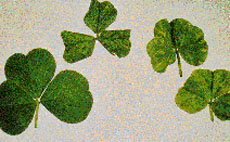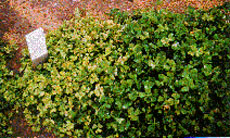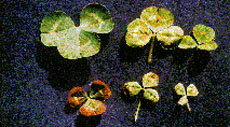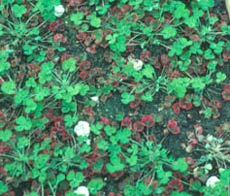
Part D - Viruses in sub clover
Introduction
A large number of viral diseases can affect sub clover. The effects of viruses are very difficult to quantify, with affected plants often dying and being replaced by healthy plants. The effects are also likely to vary over time depending on the presence of vectors (aphids) which transmit them (see Insect pests of sub clover).
Viruses of sub clover
Clover varieties differ in their tolerance to viruses. The impact of viruses is greater where infection starts early in the season. Clovers severely infected with viruses:
- produce less herbage and seed;
- have lower nutritive value;
- may be more susceptible to root diseases.
Identification of viruses from visual symptoms is difficult, as the symptoms can vary and are similar to the effects of nutrient disorders and other diseases. Laboratory tests are required for positive identification.
Subterranean clover mottle virus

Symptoms:
- Vein clearing or yellowing around the minor veins of newly expanded leaves, followed by mottling of older leaves.
- Plants become dwarfed and leaves distorted.
Sub clover mottle virus was first recorded in 1980. The virus is contact-transmissible, passing between plants via the grazing animal. Surveys indicate it is one of the most widespread viruses of clover. Properties with high stocking rates appear to be the most affected by this disease, and it is most apparent around gateways and sheep camps. The virus can be transmitted in seed. The virus can only survive in living tissue and not in soil or plant debris.
Varieties that have a useful resistance to this virus include Trikkala, Larisa, Meteora, Rosedale, Gosse and Goulburn (see Table D1).
Bean yellow mosaic virus

Symptoms:
- Leaves develop mottling, leaf deformation, and distinct yellowing between the veins.
- Plants become dwarfed.
- Symptoms occur in patches of sub clover plants and along the edges of paddocks (this is in contrast to sub clover mottle virus, which is more common in trampled areas and near gates).
Bean yellow mosaic virus is mainly transmitted by bluegreen aphids, but cowpea aphids, green peach aphids and spotted alfalfa aphids are also involved. The virus only survives in living plant material and not in soil or dead material. It does not appear to be seed-borne in sub clover but may be seed-borne in some naturalised clovers. This virus can spread to lupins from infected sub clover pastures.
The varieties that have moderate resistance to this virus include Dalkeith, Nungarin and Rosedale.
Table D1. Resistance of varieties to sub clover mottle virus and bean yellow mosaic virus
| Variety | Sub clover mottle virus |
Bean yellow mosaic virus |
|---|---|---|
| Nungarin | – | MR |
| Dalkeith | HS | MR |
| Urana | – | – |
| Seaton Park LF | MR | S |
| York | S | MS |
| Trikkala | HR | S |
| Riverina | – | – |
| Gosse | HR | S |
| Napier | – | – |
| Rosedale | HR | MR |
| Junee | HS | MS |
| Coolamon | – | – |
| Woogenellup | HS | S |
| Goulburn | MR | S |
| Denmark | MR | HS |
| Leura | MR | HS |
| Clare | HR | S |
| Nuba | MR | – |
| Mount Barker* | S | S |
| Meteora* | HR | HS |
| Karridale* | MS | HS |
HS = highly susceptible
S = susceptible
MS = moderately susceptible
MR = moderately resistant
R = resistant
HR = highly resistant
* These varieties are superseded by newer varieties.
Subterranean clover stunt virus

Symptoms:
- Young leaves of affected plants become severely stunted and yellow.
- Older leaves turn orange-red.
The disease is more common in tableland areas and affects some cultivars, such as Woogenellup, more than others. It is transferred via aphids in autumn from white clover and lucerne. While very common in the 1950s and 60s it now tends to occur in localised epidemics following migrations of the cowpea aphid vector. Affected plants die in spring, with healthy plants dominating.
Subterranean clover red leaf virus

Symptoms:
- Leaves of plants become bright red, particularly on the edges.
- Symptoms are easily confused with boron or magnesium deficiency, or the effects of root disease.
This virus over-summers in other hosts such as white clover, and is transferred to sub clover by aphids in autumn. This virus is more common in higher-rainfall areas where white clover is present. It can cause loss of young seedlings or, if infection occurs in spring, collapse of pastures before they can be cut for hay.
Cucumber mosaic virus
Symptoms:
- Leaves curl downwards and develop a slight mottle.
- Plants become dwarfed.
- The disease tends to diminish in the second year.
The disease occurs as a result of sowing infected seed, and usually diminishes in subsequent years. The spread of this disease is faster in pure clover pastures, and is lessened by the presence of grasses.
Trikkala has above average tolerance to cucumber mosaic virus.
Alfalfa mosaic virus
Symptom:
- Develops slightly smaller leaves.
This virus is difficult to diagnose, with infected leaves showing few symptoms except for developing slightly smaller leaves.
Sub clover that is growing close to white clover and lucerne is more at risk of contracting this disease. The virus is transmitted by many different aphids but has only become a problem in clover pastures since the introduction of bluegreen aphids in the late 1970s. Alfalfa mosaic virus can also be transferred in seed at very low levels.
Subterranean clover yellow vein virus
Symptom:
- Leaves have yellow veins.
Sub clover yellow vein virus is one of the more common viruses and, unlike other viruses, is present throughout the growing season. Like sub clover red leaf virus, it over-summers in perennial hosts such as white clover and is transferred by aphids.
Varieties differ in their tolerance to this virus.
Management to minimise losses from viruses
- Reduce grazing intensity to allow healthy plants to shade out infected plants.
- Increase the proportion of grasses in the pasture — this will reduce the spread of viruses between clover plants by aphids and grazing animals.
- Always sow virus-free seed.
- Sow varieties with a high level of resistance.
- Control aphids where they are spreading bean yellow mosaic virus.
Further information
For further information on subterranean clover, see the other sections of this Agfact:
- Part A Subterranean clover in New South Wales - identification and use
- Part B Diseases of sub clover
- Part C Insect pests of sub clover
- Part E Sub clover varieties and their identification
- Part F Choosing the right sub clover variety
- Part G Establishing sub clover
For further information on viruses in sub clover, see:
- Rural Research, Vol. 155, Winter 1992, pp. 4–10.
- Journal of Agriculture Western Australia, Vol. 35, 1994. pp. 40–46.

